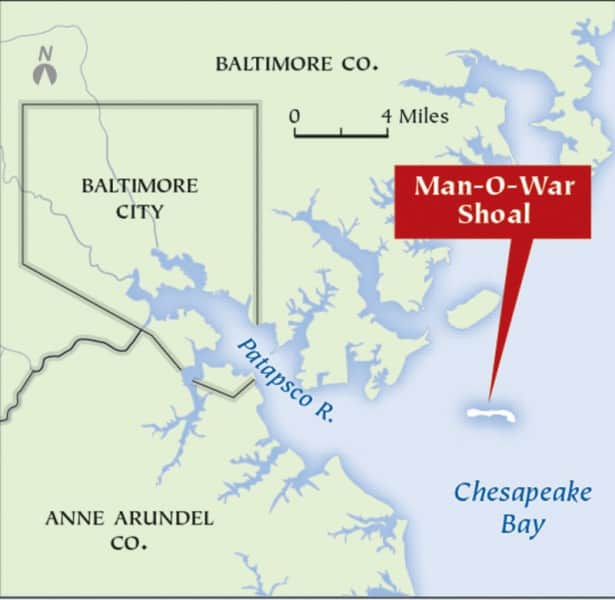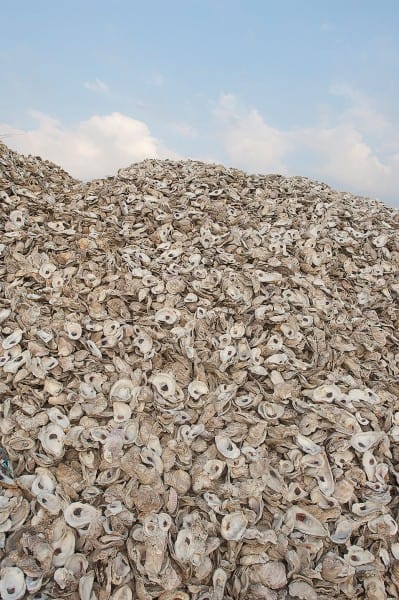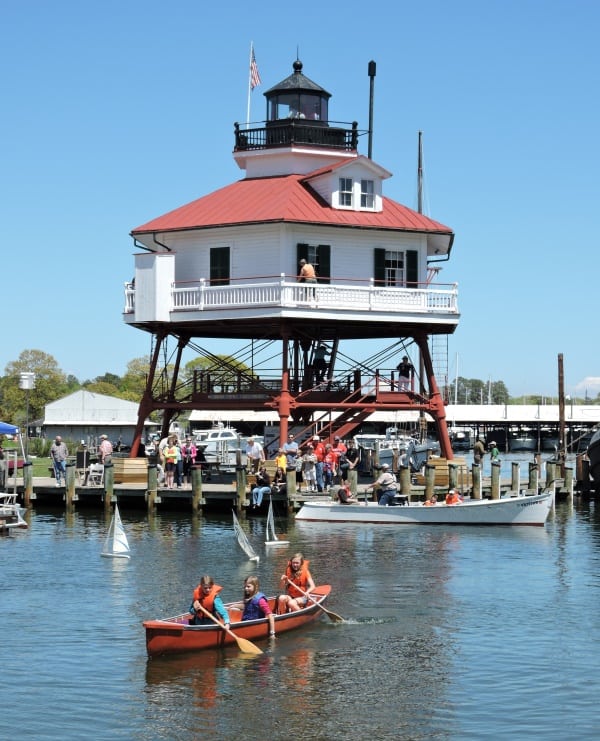By Timothy Wheeler, Bay Journal News Service
Dave Harp, Bay Journal News ServiceAfter years of scrutiny, federal regulators have given a qualified green light to a controversial Maryland plan to dredge old oyster shells from an ancient reef near Baltimore — a project intended to enhance oyster habitat elsewhere in the Chesapeake Bay, but also to help the sagging commercial fishery.
The Baltimore District of the U.S. Army Corps of Engineers issued a provisional permit on May 17 to the state Department of Natural Resources to take up to 5 million bushels of shells from Man O’ War Shoal just outside the mouth of the Patapsco River and use the shell to replenish or rebuild oyster reefs at other Bay locations.
The Corps’ conditional approval comes after nearly three years of effort by the DNR to address questions and concerns raised about the project, which is opposed by environmentalists, recreational anglers and even some watermen.
But now, having won the federal go-ahead, state officials appear in no hurry to act on it. They haven’t even informed those in favor of dredging the shoals about the Corps’ decision.
Man O’ War Shoal harbors up to 100 million bushels of shells in its 446-acre footprint, according to a 1988 survey. Though productive long ago, it has relatively few live oysters now, despite repeated efforts to reseed it.
In a natural setting, baby oysters, known as spat, attach to and grow on other oyster shells. But with Maryland and Virginia both embarking on large-scale efforts to restore oyster reefs in a total of 10 Chesapeake Bay tributaries, there’s a much greater need for shell substrate than in the past. With the commercial harvest today far smaller than it was decades ago, fresh oyster shells for reef replenishment are in short supply, and costly.
For that reason, the DNR wants the shoal’s shells to replenish oyster reefs in waters open to commercial harvest, restore other reefs in sanctuary areas and help private oyster growers. State officials hope that once the newly issued five-year permit runs its course, they can renew it to take a total of 30 million bushels, or about 30 percent of the reef.
DNR officials — and some watermen — say the shell cache in Man O’ War is just the ticket to rebuild the Bay’s lost oyster habitat and sustain the traditional wild harvest.
“That’s a lot of shell,” Talbot County waterman Jeff Harrison said. It’s far more, he noted, than watermen’s groups have been able to buy from shucking houses and plant on harvestable reefs. Most of those plantings are funded publicly via the DNR, drawn from $2 million paid annually by the Maryland Port Administration to mitigate impacts of shipping channel-dredging in the Bay.
But anglers say that Man O’ War is one of the best fishing spots in the Upper Chesapeake for white perch and striped bass, and that dredging could ruin it and the rich underwater habitat. Conservationists also argue that other materials can be used to rebuild reefs.
A recent report by the National Oceanic and Atmospheric Administration’s Chesapeake Bay office points out that granite and concrete have been successfully used as substrate on reef restoration projects, attracting abundant spat.

But many watermen believe that natural oyster shell is the best and only suitable substrate for reefs, and they persuaded the Hogan administration to delay work on a federally funded restoration project in the Tred Avon River over its use of granite to build reefs. Ultimately, watermen and the DNR lifted their opposition to granite, but only for that project, after the Army Corps of Engineers warned that the work was in jeopardy because there weren’t enough clam shells — the specified alternative — to finish in a timely fashion.
Opponents of dredging Man O’ War vastly outnumbered supporters at public hearings in 2016 on the DNR permit application. Critics also warned that, even if dredging is approved, 5 million bushels of shell wouldn’t be enough to meet all of the needs in state waters, especially if alternative substrates are ruled out. The DNR has estimated that about 11 million bushels would be needed over the five-year life of the permit for supporting reef restoration, replenishing harvest reefs and aiding aquaculture. That’s more than twice the amount of shell the state is seeking to obtain at Man O’ War.
Another issue is how the shell would be used.
Allison Colden, senior fisheries scientist with the Chesapeake Bay Foundation, acknowledged that the Annapolis-based environmental group once supported dredging Man O’ War Shoal. But that was nearly a decade ago, she said, when the DNR specified that 90 percent of the shell to be taken would be used in restoring oyster habitat in sanctuaries.
In its latest application, the DNR has not spelled out how the shell would be distributed, offering instead three scenarios with widely different splits. Without assurances that the dredged shell would be reserved for restoration, Colden said, the CBF no longer supports it. And it makes no sense, she added, to whittle away one of the last large reefs sticking up off the bottom in the Bay to provide short-term relief for the commercial fishery.
“We are embarking on this large-scale effort to restore oyster reefs to what they used to be,” Colden said. “That’s our last remaining example of what oyster reefs can and should look like in the Bay.”
In response to questions and concerns voiced by Corps reviewers, the DNR has tweaked and revised its dredging plans repeatedly since resubmitting them in 2015 — so much so that critics contend the project ought to undergo a fresh review.
As now planned, the DNR would extract shell using a hydraulic dredge to carve a total of 10 trenches, which would extend about a third of the way into the reef and measure about 500 feet wide, disturbing no more than 32 acres. The DNR agreed to steer clear of a 61-acre oyster sanctuary on one portion of the reef, even though it hasn’t had any measurable oyster reproduction in recent years.
Among other conditions imposed by the permit are limitations on when dredging can occur. It’s prohibited from Feb. 15 to June 15 to protect spawning migratory fish from the noise and turbidity generated by excavating shells from the bottom.
Dredging is also generally outlawed from June 1 to Sept. 30 to prevent harm to any wild oyster larvae or spat that might be in the water at the time. But the DNR can seek a waiver from the latter blackout after June 15 if the dredged shell is to be immediately planted at sites that are expected to take advantage of natural oyster reproduction, according to Sarah Lazo, spokeswoman for the Baltimore District.
Under the terms of the permit, the DNR would be required to spend the first year monitoring water quality and fish populations around Man O’ War, after which it could dredge 2 million bushels. There would then be a two-year hiatus for more monitoring and analysis and, if that showed no harm, the DNR would be allowed to dredge another 3 million bushels by the fifth year. If all goes well, the DNR could then apply to continue dredging for a total of 30 million bushels.
Chris Judy, the DNR’s shellfish division manager, said state officials hadn’t announced the Corps’ permit approval or even notified stakeholders because they considered it “pre-decisional” until it receives approval from state agencies.
The Corps specified that the permit won’t take effect until and unless the Maryland Department of the Environment provides a certification that the project won’t harm water quality or coastal resources. The MDE said in October that it had made those determinations. But those certifications won’t be made until the project receives a license from the state Board of Public Works.
The three-member board, made up of Gov. Larry Hogan, Comptroller Peter Franchot and Treasurer Nancy Kopp, decides whether to grant state licenses to dredging projects such as this. The board issued a request for public comment on the Man O’ War project in November but has yet to set a date for deciding the case.
“I don’t think that it will move forward in the near future,” said William Morgante, the board’s wetlands administrator, on Tuesday. When asked why, he said he’d have to get guidance on what more he could say. He later referred further questions to the board members.
Amelia Chasse, the governor’s communications director, said that the Hogan administration continues to support dredging shell from Man O’ War Shoal.
“Some local stakeholders have raised questions to the Board of Public Works,” she added, “and we are working to look into their concerns and attempt to resolve them so we can move forward with this important project.” She provided no specifics.
Len Foxwell, the comptroller’s chief of staff, said Franchot has already made clear his opposition to dredging Man O’ War out of concern for the project’s ecological impacts.
Suzanne Brogan, deputy state treasurer for public policy, said Kopp had also raised concerns about dredging the shoal after meeting with the DNR secretary and with recreational fishing and conservation groups opposed to the project.
Harrison, the waterman, suggested that given the controversy around the project, the Hogan administration may be holding off on pressing for board action until after the election. But he said Maryland’s oyster industry needs help now, as the wild harvest has declined significantly over the last three years.
“I don’t want to wait for anything,” he said. “I wanted it to happen last year.”




